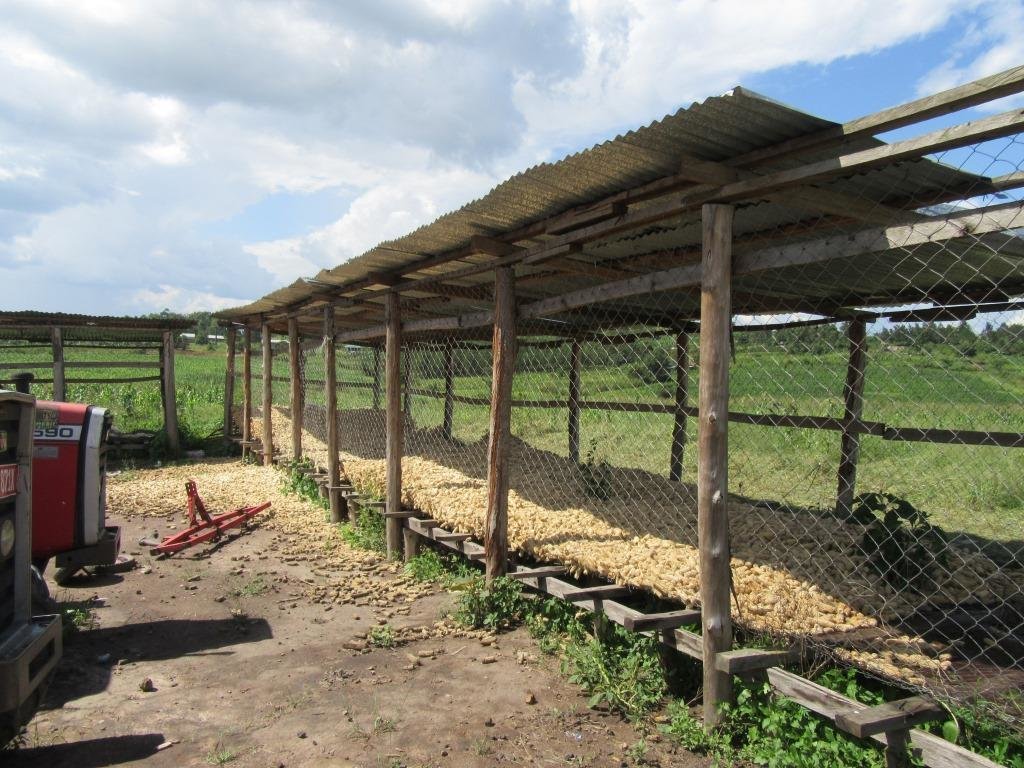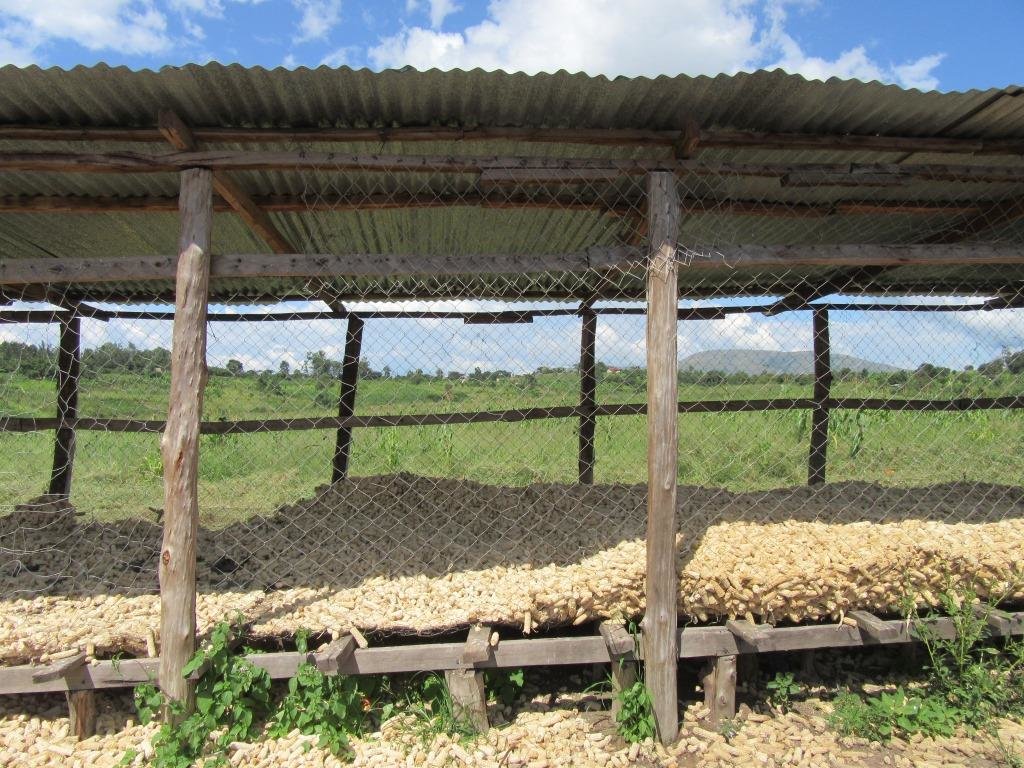Wire Mesh Maize Storage Crib [ยูกันดา]
- ผู้สร้างสรรค์:
- การอัพเดท:
- ผู้รวบรวม: PRISCILLA VIVIAN KYOSABA
- ผู้เรียบเรียง: Jalia Namakula, Kamugisha Rick Nelson
- ผู้ตรวจสอบ: Udo Höggel
Akaju k'obutimba akubarabikamu ebikyoli
technologies_3375 - ยูกันดา
ดูส่วนย่อย
ขยายทั้งหมด ย่อทั้งหมด1. ข้อมูลทั่วไป
1.2 รายละเอียดที่ติดต่อได้ของผู้รวบรวมและองค์กรที่เกี่ยวข้องในการประเมินและการจัดเตรียมทำเอกสารของเทคโนโลยี
วิทยากรหลัก
ผู้ใช้ที่ดิน:
Musinguzi Garuga
Kamwenge District, South Western Uganda
ยูกันดา
ชื่อของโครงการซึ่งอำนวยความสะดวกในการทำเอกสารหรือการประเมินเทคโนโลยี (ถ้าเกี่ยวข้อง)
Scaling-up SLM practices by smallholder farmers (IFAD)ชื่อขององค์กรซึ่งอำนวยความสะดวกในการทำเอกสารหรือการประเมินเทคโนโลยี (ถ้าเกี่ยวข้อง)
National Agricultural Research Organisation (NARO) - ยูกันดา1.3 เงื่อนไขการใช้ข้อมูลที่ได้บันทึกผ่านทาง WOCAT
วันที่เก็บรวบรวมข้อมูล(ภาคสนาม) :
15/11/2017
ผู้รวบรวมและวิทยากรหลักยอมรับเงื่อนไขเกี่ยวกับการใช้ข้อมูลที่ถูกบันทึกผ่านทาง WOCAT:
ใช่
1.4 การเปิดเผยเรื่องความยั่งยืนของเทคโนโลยีที่ได้อธิบายไว้
เทคโนโลยีที่ได้อธิบายไว้นี้เป็นปัญหาของความเสื่อมโทรมโทรมของที่ดินหรือไม่ จึงไม่ได้รับการยอมรับว่าเป็นเทคโนโลยีเพื่อการจัดการที่ดินอย่างยั่งยืน:
ไม่ใช่
2. การอธิบายลักษณะของเทคโนโลยี SLM
2.1 การอธิบายแบบสั้น ๆ ของเทคโนโลยี
คำจำกัดความของเทคโนโลยี:
Wire mesh maize storage crib technology is a medium to large scale technology promoted by a farmer in Kamwenge District in South Western Uganda to prevent maize grains from being affected by rainfall. The technology allows for good air circulation which is essential for drying out the maize grains. In this way the grain quality is improved.
2.2 การอธิบายแบบละเอียดของเทคโนโลยี
คำอธิบาย:
The technology is suitable for farmers growing maize on medium to large scale for commercial purposes. It was adopted from Europe by a farmer in Kamwenge District to help in handling large quantities of maize harvests from a 50-acre farm, which is the largest piece of land under maize farming in the area. Most operations on the farm e.g. land preparation, planting, weeding, spraying and harvesting are semi mechanized. Maize harvest from the farm averages about 2,000 tons per season. This requires a reliable post- harvest handling system that can store the large volumes of maize grain safely with good quality for the market.
The storage cribs are constructed with a wire mesh which is bent to form a rectangular shape to allow more space for storage. The wire mesh structure is then placed on a wooden platform raised a 1 meter above the ground. The whole system is then protected from elements of weather by an iron sheet roof raised 3 meters away from the platform. In front of the structure is a floor space where the harvested maize is first spread on a tarpaulin for sun drying to reduce the moisture content that may be a source of mould leading to grain spoilage and reduces grain quality.
The crib is suitable for storage of maize cobs in both the humid and dry seasons in the Kamwenge area. The structure is well positioned with the longer side in a direction perpendicular to the prevailing wind direction thus facilitating natural ventilation. This allows the drying process to continue even during storage and minimises the possibility of post harvest losses through spoilage.
The storage life greatly depends on the prevailing ambient temperature and relative humidity, and other factors like the inherent moisture pests and diseases. The rectangular shape allows for more space for storage and the material used is durable to beyond 7 years if repairs are done in time. Yet, despite these advantages, the wide open wire mesh allows in birds which feed on the maize which brings about losses.
Establishment cost of the maize storage crib is mainly determined by the construction materials and size. The farmer reported using US$ 4,191.7 in total to establish the structural size of 30 m length, 12 m height and 3 m width . Maintenance activities included repairing the damaged patches on the crib plus also fumigating the units to prevent insects from damaging the poles and eating harvested maize which costs the farmer about US$ 54.8 per season.The costs involved in establishing the technology are slightly higher in the short run while in the long run the net benefits surpass the initial costs. This system is best suited for farmers practising commercial maize farming. However, small scale farmers may be able to construct small size storage cribs using cheaper materials like reeds, bamboo and wood.
2.3 รูปภาพของเทคโนโลยี
คำอธิบายภาพ:
Photo clearly shows the usefulness of the maize crib as a post handling technique
2.4 วีดีโอของเทคโนโลยี
ความคิดเห็น/อธิบายสั้นๆ:
A video for the Wire Mesh Maize Storage Crib
วันที่:
15/11/2017
สถานที่:
Kamwenge District, South Western Uganda
ชื่อผู้ถ่ายวีดีโอ:
Aine Amon
2.5 ประเทศภูมิภาค หรือสถานที่ตั้งที่เทคโนโลยีได้นำไปใช้และได้รับการครอบคลุมโดยการประเมินนี้
ประเทศ:
ยูกันดา
ภูมิภาค/รัฐ/จังหวัด:
South Western Region
ข้อมูลจำเพาะเพิ่มเติมของสถานที่ตั้ง :
Kamwenge District, South Western Uganda
Map
×2.6 วันที่การดำเนินการ
ระบุปีที่ใช้:
2007
2.7 คำแนะนำของเทคโนโลยี
ให้ระบุว่าเทคโนโลยีถูกแนะนำเข้ามาอย่างไร:
- ทางโครงการหรือจากภายนอก
ความคิดเห็น (ประเภทของโครงการ เป็นต้น) :
Through exchange visit from established farmers from other locations
3. การจัดประเภทของเทคโนโลยี SLM
3.1 วัตถุประสงค์หลักของเทคโนโลยี
- ปรับปรุงการผลิตให้ดีขึ้น
- สร้างผลกระทบทางด้านเศรษฐกิจที่เป็นประโยชน์
- Reduction of post harvest lossses
3.2 ประเภทของการใช้ที่ดินในปัจจุบันที่ได้นำเทคโนโลยีไปใช้

พื้นที่ปลูกพืช
- การปลูกพืชล้มลุกอายุปีเดียว
พืชหลัก (พืชเศรษฐกิจและพืชอาหาร):
Maize
3.3 ข้อมูลเพิ่มเติมเกี่ยวกับการใช้ที่ดิน
การใช้น้ำของที่ดินที่มีการใช้เทคโนโลยีอยู่:
- จากน้ำฝน
จำนวนของฤดูเพาะปลูกต่อปี:
- 2
3.4 กลุ่ม SLM ที่ตรงกับเทคโนโลยีนี้
- มาตรการหลังเก็บเกี่ยว
3.5 กระจายตัวของเทคโนโลยี
ระบุการกระจายตัวของเทคโนโลยี:
- ใช้ ณ จุดที่เฉพาะเจาะจงหรือเน้นไปยังบริเวณพื้นที่ขนาดเล็ก
แสดงความคิดเห็น:
Cribs constructed in the middle of the maize field.
3.6 มาตรการ SLM ที่ประกอบกันเป็นเทคโนโลยี

มาตรการอื่น ๆ
แสดงความคิดเห็น:
Maize storage construction
3.7 รูปแบบหลักของการเสื่อมโทรมของที่ดินที่ได้รับการแก้ไขโดยเทคโนโลยี

อื่น ๆ
แสดงความคิดเห็น:
Reduction of post harvest losses which contributes to saving resources e.g soil
3.8 การป้องกัน การลดลง หรือการฟื้นฟูความเสื่อมโทรมของที่ดิน
ระบุเป้าหมายของเทคโนโลยีกับความเสื่อมโทรมของที่ดิน:
- ป้องกันความเสื่อมโทรมของที่ดิน
- ไม่สามารถใช้ได้
แสดงความคิดเห็น:
Reduction of post harvest losses which contributes to saving resources e.g soil
4. ข้อมูลจำเพาะด้านเทคนิค กิจกรรมการนำไปปฏิบัติใช้ ปัจจัยนำเข้า และค่าใช้จ่าย
4.1 แบบแปลนทางเทคนิคของเทคโนโลยี
ผู้เขียน:
Prossy Kaheru
วันที่:
15/11/2017
4.2 ข้อมูลจำเพาะด้านเทคนิคและการอธิบายแบบแปลนทางเทคนิค
Crib structure dimension
-Length is 30 meters, height 4 meters and width is 3 meters
-Spacing between crib units is 2 meters
-Wire mesh size is measure depending on the size of structure in this case 30 by 4 meters
-Timber used is eucalyptus variety, pole size is 16 centimeters diameter, pole height 5.5 meters
-Gentle sloping
-Construction materials used are wire mesh, nails, timber, poles and iron sheets
4.3 ข้อมูลทั่วไปเกี่ยวกับการคำนวณปัจจัยนำเข้าและค่าใช้จ่าย
ให้ระบุว่าค่าใช้จ่ายและปัจจัยนำเข้าได้รับการคำนวณอย่างไร:
- ต่อพื้นที่ที่ใช้เทคโนโลยี
ระบุขนาดและหน่วยพื้นที่:
Crip: 30m*4m*3m
ระบุสกุลเงินที่ใช้คำนวณค่าใช้จ่าย:
- ดอลลาร์สหรัฐ
ระบุอัตราแลกเปลี่ยนจากดอลลาร์สหรัฐเป็นสกุลเงินท้องถิ่น (ถ้าเกี่ยวข้อง) คือ 1 เหรียญสหรัฐ =:
3600.0
ระบุค่าเฉลี่ยของค่าจ้างในการจ้างแรงงานต่อวัน:
50,000 Uganda shillings
4.4 กิจกรรมเพื่อการจัดตั้ง
| กิจกรรม | ประเภทของมาตรการ | ช่วงเวลาดำเนินการ | |
|---|---|---|---|
| 1. | Construction labor | ด้วยโครงสร้าง | Once |
| 2. | Wire Mesh | ด้วยโครงสร้าง | Once |
| 3. | Iron sheets | ด้วยโครงสร้าง | Once |
| 4. | Nails | ด้วยโครงสร้าง | Once |
| 5. | Timber | ด้วยโครงสร้าง | once |
| 6. | Poles | ด้วยโครงสร้าง | Once |
แสดงความคิดเห็น:
Establishing activities as reported by farmer
4.5 ค่าใช้จ่ายของปัจจัยนำเข้าที่จำเป็นสำหรับการจัดตั้ง
| ปัจจัยนำเข้า | หน่วย | ปริมาณ | ค่าใช้จ่ายต่อหน่วย | ค่าใช้จ่ายทั้งหมดต่อปัจจัยนำเข้า | %ของค่าใช้จ่ายที่ก่อให้เกิดขึ้นโดยผู้ใช้ที่ดิน | |
|---|---|---|---|---|---|---|
| แรงงาน | Construction labor | Days | 30.0 | 13.8 | 414.0 | 100.0 |
| วัสดุสำหรับก่อสร้าง | Wire Mesh | Meters | 150.0 | 7.9 | 1185.0 | 100.0 |
| วัสดุสำหรับก่อสร้าง | Poles | Pieces | 268.0 | 0.6 | 160.8 | 100.0 |
| วัสดุสำหรับก่อสร้าง | Nails | Kilograms | 105.0 | 1.2 | 126.0 | 100.0 |
| วัสดุสำหรับก่อสร้าง | Timber | Pieces | 420.0 | 1.0 | 420.0 | 100.0 |
| อื่น ๆ | Iron sheets | Pieces (2.5mX0.5m) | 120.0 | 6.2 | 744.0 | 100.0 |
| ค่าใช้จ่ายทั้งหมดของการจัดตั้งเทคโนโลยี | 3049.8 | |||||
แสดงความคิดเห็น:
All the costs were met the farmers
4.6 การบำรุงรักษาสภาพหรือกิจกรรมที่เกิดขึ้นเป็นประจำ
| กิจกรรม | ประเภทของมาตรการ | ช่วงระยะเวลา/ความถี่ | |
|---|---|---|---|
| 1. | Repairing damaged patches of the crib | ด้วยโครงสร้าง | Once a year |
| 2. | Fumigating the crib units to prevent pests | ด้วยการจัดการ | During harvesting periods |
4.7 ค่าใช้จ่ายของปัจจัยนำเข้าและกิจกรรมที่เกิดขึ้นเป็นประจำที่ต้องการการบำรุงรักษา (ต่อปี)
ถ้าเป็นไปได้ให้แจกแจงรายละเอียดต้นทุนการบำรุงรักษาตารางข้างล่างดังต่อไปนี้ ให้ชี้ระบุลงไปถึงปัจจัยการผลิตและค่าใช้จ่ายต่อปัจจัยการผลิต ถ้าคุณไม่สามารถแจกแจงรายละเอียดต้นทุนได้ ให้ทำการประมาณค่าใช้จ่ายทั้งหมดในการบำรุงรักษา:
166.0
แสดงความคิดเห็น:
Maintenance cost calculated on a yearly basis
4.8 ปัจจัยสำคัญที่สุดที่มีผลกระทบต่อค่าใช้จ่าย
ปัจจัยสำคัญที่สุดที่มีผลกระทบต่อค่าใช้จ่ายต่างๆ:
Construction materials
5. สิ่งแวดล้อมทางธรรมชาติและของมนุษย์
5.1 ภูมิอากาศ
ฝนประจำปี
- < 250 ม.ม.
- 251-500 ม.ม.
- 501-750 ม.ม.
- 751-1,000 ม.ม.
- 1,001-1,500 ม.ม.
- 1,501-2,000 ม.ม.
- 2,001-3,000 ม.ม.
- 3,001-4,000 ม.ม.
- > 4,000 ม.ม.
เขตภูมิอากาศเกษตร
- ชื้น
5.2 สภาพภูมิประเทศ
ค่าเฉลี่ยความลาดชัน:
- ราบเรียบ (0-2%)
- ลาดที่ไม่ชัน (3-5%)
- ปานกลาง (6-10%)
- เป็นลูกคลื่น (11-15%)
- เป็นเนิน (16-30%)
- ชัน (31-60%)
- ชันมาก (>60%)
ธรณีสัณฐาน:
- ที่ราบสูง/ที่ราบ
- สันเขา
- ไหล่เขา
- ไหล่เนินเขา
- ตีนเนิน
- หุบเขา
ระดับความสูง:
- 0-100 เมตร
- 101-500 เมตร
- 501-1,000 เมตร
- 1,001-1,500 เมตร
- 1,501-2,000 เมตร
- 2,001-2,500 เมตร
- 2,501-3,000 เมตร
- 3,001-4,000 เมตร
- > 4,000 เมตร
ให้ระบุถ้าเทคโนโลยีได้ถูกนำไปใช้:
- ไม่เกี่ยวข้อง
5.3 ดิน
ค่าเฉลี่ยความลึกของดิน:
- ตื้นมาก (0-20 ซ.ม.)
- ตื้น (21-50 ซ.ม.)
- ลึกปานกลาง (51-80 ซ.ม.)
- ลึก (81-120 ซ.ม.)
- ลึกมาก (>120 ซ.ม.)
เนื้อดิน (ดินชั้นบน):
- ปานกลาง (ดินร่วน ทรายแป้ง)
เนื้อดินล่าง (> 20 ซ.ม.ต่ำจากผิวดิน):
- หยาบ/เบา (ดินทราย)
อินทรียวัตถุในดิน:
- สูง (>3%)
5.4 ความเป็นประโยชน์และคุณภาพของน้ำ
ระดับน้ำใต้ดิน:
5-50 เมตร
น้ำไหลบ่าที่ผิวดิน:
ปานกลาง
คุณภาพน้ำ (ที่ยังไม่ได้บำบัด):
เป็นน้ำใช้เพื่อการเกษตรเท่านั้น (การชลประทาน)
ความเค็มของน้ำเป็นปัญหาหรือไม่:
ไม่ใช่
กำลังเกิดน้ำท่วมในพื้นที่หรือไม่:
ไม่ใช่
5.5 ความหลากหลายทางชีวภาพ
ความหลากหลายทางชนิดพันธุ์:
- สูง
ความหลากหลายของแหล่งที่อยู่:
- ปานกลาง
5.6 ลักษณะของผู้ใช้ที่ดินที่นำเทคโนโลยีไปปฏิบัติใช้
อยู่กับที่หรือเร่ร่อน:
- อยู่กับที่
แนวทางการตลาดของระบบการผลิต:
- ทำการค้า/การตลาด
รายได้ที่มาจากนอกฟาร์ม:
- 10-50% ของรายได้ทั้งหมด
ระดับของความมั่งคั่งโดยเปรียบเทียบ:
- รวย
เป็นรายบุคคล/ครัวเรือน:
- เป็นรายบุคคล/ครัวเรือน
ระดับของการใช้เครื่องจักรกล:
- การใช้เครื่องจักรหรือเครื่องยนต์
เพศ:
- ชาย
อายุของผู้ใช้ที่ดิน:
- ผู้สูงอายุ
ระบุลักษณะอื่นๆที่เกี่ยวข้องของผู้ใช้ที่ดิน:
Individual owning a company that runs all the farm activities
5.7 พื้นที่เฉลี่ยของที่ดินที่เป็นเจ้าของหรือเช่าโดยผู้ใช้ที่ดินที่นำเทคโนโลยีไปปฏิบัติใช้
- < 0.5 เฮกตาร์
- 0.5-1 เฮกตาร์
- 1-2 เฮกตาร์
- 2-5 เฮกตาร์
- 5-15 เฮกตาร์
- 15-50 เฮกตาร์
- 50-100 เฮกตาร์
- 100-500 เฮกตาร์
- 500-1,000 เฮกตาร์
- 1,000-10,000 เฮกตาร์
- >10,000 เฮกตาร์
พิจารณาว่าเป็นขนาดเล็ก กลาง หรือขนาดใหญ่ (ซึ่งอ้างอิงถึงบริบทระดับท้องถิ่น):
- ขนาดใหญ่
แสดงความคิดเห็น:
It is a large scale because the size of the farm area is 50 acres with a production of 2000 tones of maize / year
5.8 กรรมสิทธิ์ในที่ดิน สิทธิในการใช้ที่ดินและสิทธิในการใช้น้ำ
กรรมสิทธิ์ในที่ดิน:
- รายบุคคล ได้รับสิทธิครอบครอง
สิทธิในการใช้ที่ดิน:
- รายบุคคล
สิทธิในการใช้น้ำ:
- รายบุคคล
5.9 การเข้าถึงบริการและโครงสร้างพื้นฐาน
สุขภาพ:
- จน
- ปานกลาง
- ดี
การศึกษา:
- จน
- ปานกลาง
- ดี
ความช่วยเหลือทางด้านเทคนิค:
- จน
- ปานกลาง
- ดี
การจ้างงาน (เช่น ภายนอกฟาร์ม):
- จน
- ปานกลาง
- ดี
ตลาด:
- จน
- ปานกลาง
- ดี
พลังงาน:
- จน
- ปานกลาง
- ดี
ถนนและการขนส่ง:
- จน
- ปานกลาง
- ดี
น้ำดื่มและการสุขาภิบาล:
- จน
- ปานกลาง
- ดี
บริการด้านการเงิน:
- จน
- ปานกลาง
- ดี
6. ผลกระทบและสรุปคำบอกกล่าว
6.1 ผลกระทบในพื้นที่ดำเนินการ (On-site) จากการใช้เทคโนโลยี
ผลกระทบทางด้านเศรษฐกิจและสังคม
การผลิต
การผลิตพืชผล
แสดงความคิดเห็น/ระบุ:
Increased crop production since a farmer has a secure safe storage system hence he can produce more as it is stored
คุณภาพพืชผล
แสดงความคิดเห็น/ระบุ:
Being it the grains are kept properly and in a favorable environment for the grains
รายได้และค่าใช้จ่าย
รายได้จากฟาร์ม
แสดงความคิดเห็น/ระบุ:
The technology has promoted income increase simply because with the storage system a farmer can get to sell his produce
ผลกระทบด้านสังคมวัฒนธรรมอื่น ๆ
ความมั่นคงด้านอาหาร / พึ่งตนเองได้
แสดงความคิดเห็น/ระบุ:
This has helped in solving a problem of food insecurity since the maize grains can be stored for a relatively long period. Hence, at any time grains can be processed into maize flour.
6.4 การวิเคราะห์ค่าใช้จ่ายและผลประโยชน์ที่ได้รับ
ผลประโยชน์ที่ได้รับเปรียบเทียบกับค่าใช้จ่ายในการจัดตั้งเป็นอย่างไร (จากมุมมองของผู้ใช้ที่ดิน)
ผลตอบแทนระยะสั้น:
ด้านลบเล็กน้อย
ผลตอบแทนระยะยาว:
ด้านบวก
ผลประโยชน์ที่ได้รับเปรียบเทียบกับค่าใช้จ่ายในการบำรุงรักษาหรือต้นทุนที่เกิดขึ้นซ้ำอีก เป็นอย่างไร (จากมุมมองของผู้ใช้ที่ดิน)
ผลตอบแทนระยะสั้น:
ด้านลบเล็กน้อย
ผลตอบแทนระยะยาว:
ด้านบวกอย่างมาก
6.5 การปรับตัวของเทคโนโลยี
- ครั้งเดียวหรือเป็นการทดลอง
แสดงความคิดเห็น:
None has adopted the technology because of the high establishment cost and most farmers sell their farm produce immediately after harvesting.
6.6 การปรับตัว
เทคโนโลยีได้รับการปรับเปลี่ยนเมื่อเร็วๆนี้ เพื่อให้ปรับตัวเข้ากับสภาพที่กำลังเปลี่ยนแปลงหรือไม่:
ไม่ใช่
6.7 จุดแข็ง / ข้อได้เปรียบ / โอกาสของเทคโนโลยี
| จุดแข็ง / ข้อได้เปรียบ / โอกาสในทัศนคติของผู้ใช้ที่ดิน |
|---|
| Maintains the maize grains in good conditions |
| Allows drying process to continue even during storage time |
| The farmer generates more income since he sells when the market prices are favorable |
| จุดแข็ง / ข้อได้เปรียบ / โอกาสในทัศนคติของผู้รวบรวมหรือวิทยากรหลัก |
|---|
| Quite a good innovation practice especially for those farmers growing maize on large scale for commercial purposes |
| Reliable post harvesting technique |
| Reliable storage system |
6.8 จุดอ่อน / ข้อเสียเปรียบ / ความเสี่ยงของเทคโนโลยีและวิธีการแก้ไข
| จุดอ่อน / ข้อเสียเปรียบ / ความเสี่ยงในทัศนคติของผู้ใช้ที่ดิน | มีวิธีการแก้ไขได้อย่างไร |
|---|---|
| Crib establishment is relatively costly | Farmers opt for cheap system like the traditional granaries |
| Best for farmers growing maize on a very large scale for commercial purposes | To be adopted by farmers growing maize on commercial scale |
| Fumigating the units during harvest period is relatively expensive |
| จุดอ่อน / ข้อเสียเปรียบ / ความเสี่ยงในทัศนคติของผู้รวบรวมหรือวิทยากรหลัก | มีวิธีการแก้ไขได้อย่างไร |
|---|---|
| Only favors farmers who can handle the establishment cost | Farmer organisations and government should come in to help middle farmers by providing them with establishment materials at a relatively lower price, this will enable them adopt the system. |
7. การอ้างอิงและการเชื่อมต่อ
7.1 วิธีการและแหล่งข้อมูล
- ไปเยี่ยมชมภาคสนาม การสำรวจพื้นที่ภาคสนาม
one
- การสัมภาษณ์กับผู้ใช้ที่ดิน
One person in this case the farm manager
7.3 เชื่อมโยงกับข้อมูลที่มีอยู่บนออนไลน์
ชื่อเรื่องหรือคำอธิบาย:
Economic importance of different maize storage structures in Kenya
URL:
https://www.slideshare.net/pchenevixtrench/economic-importance-of-different-maize-storage-structures-in-kenya
ชื่อเรื่องหรือคำอธิบาย:
Does Improved Storage Technology modern input use and food security? Evidence of randomized trial in Uganda
URL:
https://www.sciencedirect.com/science/article/pii/S030438781830926X
ลิงก์และโมดูล
ขยายทั้งหมด ย่อทั้งหมดลิงก์
ไม่มีลิงก์
โมดูล
ไม่มีโมดูล





